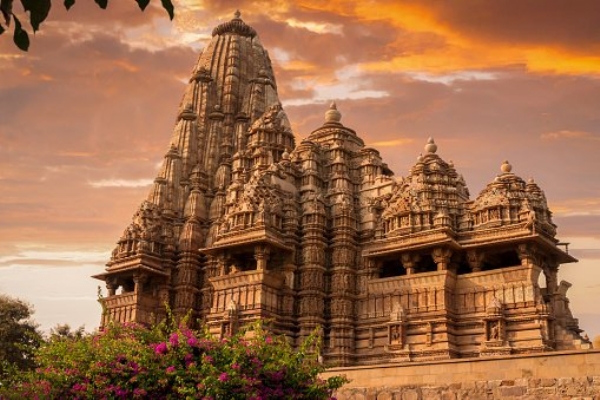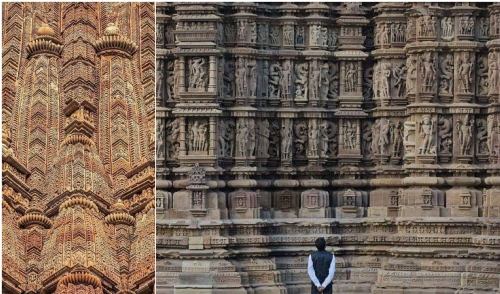Kandariya Mahadeva Temple: The architectural pride of Khajuraho!
Being part of Khajuraho Group of Monuments, the Kandariya Mahadeva temple has 20 Hindu & Jain shrines in Chhatarpur & is the largest, most ornate of the Hindu temples
Total Views |
We may across many structures that we find beautiful or rare. But once in a while, we across something so special, which goes above & beyond everything we've ever across. Today, let's look at a temple just like that; when it comes to its architecture, it will definitely be the most unique and intricate one you’ve come ever across! With the Angkor Wat temple in Cambodia, the Taj Mahal in India, the Kandariya Mahadeva Temple in Madhya Pradesh, India, is among the most magnificent examples of religious art in the entire Asia.

Being part of the medieval Khajuraho Group of Monuments, which are a UNESCO World Heritage Site comprising of 20 Hindu & Jain shrines located in Chhatarpur, about 620 km southeast of New Delhi, the Kandariya Mahadeva is the largest and most ornate of the Hindu temples and is known for its Nagara-style architecture, characterized by a central tower, as well as its sculpture, which appears throughout the building.
History | Khajuraho was formerly the religious capital of the Chandela Rajputs. The Kandariya Mahadeva was constructed about 1017-1029 by King Ganda, one of their greatest figures. The temple is dedicated to Lord Shiva, one of the three most important sects in Hinduism.
KANDARIYA MAHADEV TEMPLE, is the largest of all the KHAJURAHO temples, with a height of 116.5 feet above the ground.
— Vikrant (@Lost_History1) March 14, 2020
There are no less than 226 statues inside the temple, and 646 outside, or 872 statues altogether, of which greater number are from 2 to nearly 3 feet in height. pic.twitter.com/FdPi5JxeJ7
Almost all of the temples at Khajuraho were constructed between 950 & 1050 CE by the Chandela dynasty. They became the most powerful rulers of northern / central India from the 9th to the 12th century & reached their zenith in 1030. Records say that during the 12th century, the site had 85 temples spread out over 20 square kms. Today, only about 20 temples are still standing.
Of these 20, the biggest surviving Shiva shrine is Khandarya Mahadeva, while the largest Vishnu shrines include those of Chaturbhuja and Ramachandra. Although still in active use in 1200, during the next century, the complex was overrun by the Delhi Sultanate forces, under the command of the Muslim Sultan Qutb-ud-din Aibak. Under their rule, some temples were destroyed, while the others were left abandoned. In the 1830s, a British surveyor called T.S. Burt, "rediscovered" these temples and brought them to the attention of the rest of the world.
Also Read | Bateshwar: the restored glory of ancient 200 temples!
Architecture | The temple occupies an area of about 6,500 square feet and rises 117 feet above ground level. Like all the temples, except Chaturbhuja, Kandariya Mahadev faces east, and is built upon a raised platform, approached by a steep flight of steps. A rectangular entrance hall (ardhamandapa) leads from the steps into a central pillared hall (mandapa). This leads to the darkened sanctuary (garbhagrha) above which is the main tower and spire. Inside the sanctuary is the Shiv linga.
The sanctum and mandapa are surrounded by an ambulatory. Throughout the building the architecture and the accompanying decorative art is symbolic, having the pattern of Hindu iconography. Thus, the ornate carvings on the pillars, walls and ceilings of the interior as well as the exterior of the temple include depictions of kama, artha, dharma and moksa - the four just and necessary pursuits of life.

The exterior structure of the temple is based on a shikhara, which symbolizes Mount Kailash, Shiva's Himalayan Mountain home. This main tower is surrounded by 84 smaller spires. The whole building is made of sandstone, with a granite foundation. No mortar was used in the temple's construction: the stones were connected with mortise and tenon joints, held in place by gravity. The columns and architraves are composed of megaliths weighing up to 20 tons!
Also Read | Angkor Wat, the largest temple complex in the world dedicated to Vishnu
The temple is detailed with many stone sculptures, depicting matters of everyday life, along with animals & humans. On the exterior of the towers, are repetitive murals of intricately carved human and divine figures. The quality of the carving is truly high due to the superior quality of the sandstone used. Hence, sculptors were able to represent fine details, including strands of hair, intricate jewellery & even manicured nails!


